A Review of Power Transformer Vibration and Noise Caused by Silicon Steel Magnetostriction
Abstract
:1. Introduction
2. The Microscopic Mechanism of Magnetostriction
3. Vibration and Noise Caused by Magnetostriction
- (1)
- High-order harmonics of 450 Hz and 650 Hz have been observed in the iron core joint region (point 3 and 4). This phenomenon is likely attributed to the combined effects of rotational magnetic flux at the joint and electromagnetic forces between the gaps.
- (2)
- The vibration acceleration effective value perpendicular to the surface of the iron core (at points 1 and 3) is higher than the vibration acceleration parallel to the surface of the iron core (at points 2, 4, and 5). This is because the silicon steel sheet in the iron core is mainly magnetized in the RD, and the direction of magnetostriction coincides with the RD, However, both ends of the silicon steel sheet are subjected to six degrees of freedom constraints. Therefore, the deformation caused by magnetostrictive elongation cannot be released at both ends, resulting in bending and torsional deformation in the middle of the silicon steel sheet. Therefore, the vibrations perpendicular to the surface of the iron core are caused by the combined effect of magnetostrictive deformation in the RD of the silicon steel sheet and deformation at the joints, while the vibrations parallel to the surface of the iron core are solely caused by the magnetostrictive deformation of the silicon steel sheet.
- (3)
- In the same direction, the vibration in the central region of the iron core is significantly smaller than the vibration in the joint region (point 1 < point 3, point 2 < point 4). The silicon steel sheets in the central region of the iron core are magnetized in the TD, while the joint region experiences rotational magnetic flux, which magnetizes the silicon steel sheets in the TD. The magnetostrictive value in the TD is greater than that in the RD, and there is a certain electromagnetic force at the joint.
4. Factors Influencing the Magnetostriction
4.1. The Influence of Mechanical Stress on Magnetostriction
4.2. The Influence of Processing Techniques on Magnetostriction
4.3. The Magnetostriction of Silicon Steel Sheets under Different Operating Conditions
4.3.1. The Magnetostriction of Silicon Steel Sheets under Tri-Harmonic Excitation
4.3.2. The Magnetostriction of Silicon Steel Sheets under DC Bias
5. Measurement of Magnetostriction
6. The Model of Magnetostriction
6.1. Consider the Laminated Iron Core Model for Magnetostriction
6.1.1. Based on Data Testing of Magnetostrictive Effect
6.1.2. Based on Phenomenological Theory of Magnetostrictive Effect
6.1.3. Based on Magnetostriction Theory of Magnetostrictive Effect
6.1.4. Based on Thermodynamics of Magnetostrictive Effect
6.2. Noise Reduction Methods Based on Magnetostriction
7. Conclusions
- (1)
- The mutual influence between the iron core and the winding vibration. In most studies on transformer core vibration, the focus is primarily on the magnetostriction of silicon steel sheets and the vibration caused by Maxwell forces at the core joints. However, in actual equipment, the winding coil is installed on the iron core, and the vibration of the two will affect each other. The vibration of the winding will excite the vibration of the iron core, which in turn affects the vibration noise of the transformer. Therefore, the study of the coupling and transmission relationships between the two is a further understanding of the mechanism of transformer vibration noise.
- (2)
- The application of emerging methods. With the continuous emergence of new theoretical systems, new materials, new measurement methods, and new instruments and equipment, new tools have been provided to achieve a more accurate understanding of the noise mechanism of transformers. For instance, traditional hysteresis models (such as Preisach model, play model, and DPC model) encounter difficulties in modeling nonlinear relationships. By combining the idea of hysteresis operator in traditional models with deep learning algorithms, vector hysteresis modeling can achieve high accuracy and generalization ability [48], which provides a new reference for magnetostriction modeling. The use of new measurement methods and equipment can provide a more detailed understanding of the mechanism and propagation characteristics of transformer noise, thereby enabling targeted noise reduction measures.
- (3)
- A noise reduction method based on the modal characteristics of transformers. The modal characteristics of transformers can be altered by changing the clamping force, mechanical structure, adding damping materials, altering the mass and stiffness, and other means. There is currently limited research on the modal characteristics of transformers under specific excitations. Studying the modal characteristics under certain excitations, such as DC and high-order harmonics, can be achieved through effective and reliable means to reduce vibration and noise.
- (4)
- At present, the power system shows a high proportion of renewable energy and a large proportion of power electronic equipment important characteristics, large capacity medium and high frequency transformer because of its high frequency, the core power density is larger, compared with the power frequency has a small size and light weight characteristics, more and more widely used. However, because the excitation voltage waveform is often more complicated during its operation, its vibration and noise are more complicated. Therefore, based on the research of traditional power frequency transformer, it is necessary to research and innovate the medium and high frequency transformer.
Author Contributions
Funding
Conflicts of Interest
References
- China Electric Power Enterprises Federation. Annual Development Report of China’s Power Industry 2023. China Electr. Power News 2023, 3. [Google Scholar] [CrossRef]
- National Energy Administration; China Electric Power Enterprises Federation. 2021 National Annual Report on Power System Reliability. Available online: http://prpq.nea.gov.cn/ndbg/8540.html (accessed on 19 August 2022).
- Haro-Larrode, M. Variable Reactance Criteria to Mitigate Voltage Deviations in Power Transformers in Light- and Over-Load Conditions. Machines 2023, 11, 797. [Google Scholar] [CrossRef]
- Zhang, P.; Li, L.; Cheng, Z.; Tian, C.; Han, Y. Study on Vibration of Iron Core of Transformer and Reactor Based on Maxwell Stress and Anisotropic Magnetostriction. IEEE Trans. Magn. 2019, 55, 1–5. [Google Scholar] [CrossRef]
- Ji, S.; Shi, Y.; Zhang, F.; Lu, F. Review on Vibration and Noise of Power Transformer and Its Control Measures. High Volt. Appar. 2019, 55, 1–17. [Google Scholar] [CrossRef]
- Ling, N.; Du, X.; An, W.; Wu, J.; Gao, Q.; Li, X.; Li, S. Review of distribution transformer reliability assessment. Electrotech. Appl. 2023, 42, 45–52. [Google Scholar]
- Xia, B.; Han, S.; Zhang, N.; Liu, S. Research status and development trend of silicon steel. China Metall. 2018, 28, 9–12. [Google Scholar] [CrossRef]
- Azuma, D.; Hasegawa, R. Audible Noise from Amorphous Metal and Silicon Steel-Based Transformer Core. IEEE Trans. Magn. 2008, 44, 4104–4106. [Google Scholar] [CrossRef]
- Mao, M.; Yang, P. Material Science Principles on Electrical Steels, 1st ed.; Higher Education Press: Beijing, China, 2013; pp. 65–135. [Google Scholar]
- Tan, Y.; Ren, L. Theory and Application of Magnetostrictive Sensors, 1st ed.; Science Press: Beijing, China, 2022; pp. 1–27. [Google Scholar]
- Standard IEC60404-17; Magnetic Materials-Part 17: Methods of Measurement of the Magnetostriction Characteristics of Grain-oriented Electrical Steel Strip and Sheet by Means of a Single Sheet Tester and an Optical Sensor. International Electrotechnical Commission: London, UK, 2021.
- Imamura, M.; Sasaki, T.; Saito, A. Magnetization process and magnetostriction of a four percent Si-Fe single crystal close to (110) [001]. IEEE Trans. Magn. 1981, 17, 2479–2485. [Google Scholar] [CrossRef]
- Zhang, L.; Wang, G.; Dong, P.; Zou, L.; Zhao, T. Study on the Vibration of Grain-oriented Transformer Core Based on the Magnetostrictive Intrinsic Characteristics. Proc. CSEE 2016, 36, 3990–4001. [Google Scholar] [CrossRef]
- He, Q.; Nie, J.; Zhang, S.; Chen, X. Study of Transformer Core Vibration and Noise Generation Mechanism Induced by Magnetostriction of Grain-Oriented Silicon Steel Sheet. Hindawi 2021, 2021, 8850780. [Google Scholar] [CrossRef]
- Zhang, Y.; Li, Q.; Zhang, D.; Bai, B.; Xie, D.; Koh, C.S. Magnetostriction of silicon steel sheets under different magnetization conditions. IEEE Trans. Magn. 2016, 52, 1–4. [Google Scholar] [CrossRef]
- Zhang, P. Research on Magnetostrictive Properties of Soft Magnetic Materials and Vibration of Electric Power Equipment Core under Complex Working Conditions. Ph.D. Thesis, North China Electric Power University, Beijing, China, 2019. [Google Scholar]
- Sha, R.; Zhu, L.; Han, T.; Zhang, H.; Zhang, X. Measurement and analysis of magnetic properties of silicon steel sheet under mechanical stress. J. Mach. Des. 2019, 36 (Suppl. S1), 51–55. [Google Scholar] [CrossRef]
- Lobue, M.; Sasso, C.; Basso, V.; Fiorillo, F.; Bertotti, G. Power losses and magnetization process in Fe–Si non-oriented steels under tensile and compressive stress. J. Magn. Magn. Mater. 2000, 215, 124–126. [Google Scholar] [CrossRef]
- Moses, A.J. Effects of applied stress on the magnetic properties of high permeability silicon-iron. IEEE Trans. Magn. 1979, 15, 1575–1579. [Google Scholar] [CrossRef]
- Anderson, P.I.; Moses, A.J.; Stanbury, H.J. An automated system for the measurement of magnetostriction in electrical steel sheet under applied stress. J. Magn. Magn. Mater. 2000, 215, 714–716. [Google Scholar] [CrossRef]
- Anderson, P.I.; Moses, A.J.; Stanbury, H.J. Assessment of the stress sensitivity of magnetostriction in grain-oriented silicon steel. IEEE Trans. Magn. 2007, 43, 3467–3476. [Google Scholar] [CrossRef]
- Klimczyk, P.; Moses, A.J.; Anderson, P.; Martyn, D. Challenges in magnetostriction measurements under stress. Prz. Elektrotechniczny 2009, 85, 100–102. [Google Scholar]
- Zhu, L.; Yang, Q.; Yan, R.; Chen, H. Numerical Calculation of Magnetostrictive Stress of Core in Power Transformer. Transformer 2012, 49, 9–13. [Google Scholar] [CrossRef]
- Dou, Y.; Li, Y.; Zhang, C.; Yue, S.; Zhu, J. Effects of uniaxial stress along different directions on alternating magnetic properties of silicon steel sheets. IEEE Trans. Magn. 2020, 56, 1–4. [Google Scholar] [CrossRef]
- Zhao, J.; Zhang, L.; Liu, Y.; Dong, L.; Yi, Z. Experimental Study on the Effect of Mechanical Stress on the Comprehensive Magnetic Properties of the Grain-Oriented Silicon Steel. Trans. China Electrotech. Soc. 2022, 37, 5776–5787. [Google Scholar] [CrossRef]
- Liu, T. Effect of Deformation and Annealing on Microstructure and Magnetic Properties of Non-oriented Silicon Steel. Ph.D. Thesis, Hefei University of Technology, Hefei, China, 2019. [Google Scholar]
- Anderson, P. Measurement of the stress sensitivity of magnetostriction in electrical steels under distorted waveform conditions. J. Magn. Magn. Mater. 2008, 320, e583–e588. [Google Scholar] [CrossRef]
- Chen, L.; Ma, G.; Tong, D.; Yang, F.; Chen, X.; Dong, H. Performance evaluation law of grain-oriented silicon steel in transformer core after 25 years service. J. Iron Steel Res. 2018, 30, 71–78. [Google Scholar] [CrossRef]
- Moses, A.J.; Pike, E.C. Influence of surface coating on transverse magnetostriction in silicon iron. Proc. Inst. Electr. Eng. 1977, 124, 583–585. [Google Scholar] [CrossRef]
- Gorji Ghalamestani, S.; Vandevelde, L.; Dirckx, J.J.; Melkebeek, J.A. Magnetostriction and the Influence of Higher Harmonics in the Magnetic Field. IEEE Trans. Magn. 2012, 48, 3981–3984. [Google Scholar] [CrossRef]
- Wang, Y.; Gao, C.; Li, L.; Feng, Y.; Liu, Y. Study for Influence of Harmonic Magnetic Fields on Vibration Properties of Core of Anode Saturable Reactor in HVDC Converter Valve System. IEEE Access 2021, 9, 24050–24059. [Google Scholar] [CrossRef]
- Gao, P.; Wang, H.; Su, L. Application of multifractal spectrum to the vibration analyses of power transformer under DC bias. In Proceedings of the IEEE PES General Meeting, Conference & Exposition, National Harbor, MD, USA, 27–31 July 2014. [Google Scholar]
- Helmut, P.; Georgi, S.; Claes, B.; Gerald, T.; Erich, G. Effects of DC Bias on Regional Flux and Magnetostriction of a Single-Phase Transformer Core Modeled by 3-D MACC. IEEE Trans. Magn. 2018, 54, 1–6. [Google Scholar] [CrossRef]
- Zhao, X.; Du, Y.; Liu, Y. Vibration Characteristics Analysis of Iron Core Under DC-biased Condition by Solving Coupled Magneto-mechanical Field in Frequency-domain. High. Volt. Eng. 2020, 46, 1216–1225. [Google Scholar] [CrossRef]
- Li, Y.; Zhu, J.; Li, Y.; Wang, H.; Zhu, L. Modeling dynamic magnetostriction of amorphous core materials based on Jiles-Atherton theory for finite element simulations. J. Magn. Magn. Mater. 2021, 529, 167854. [Google Scholar] [CrossRef]
- Dou, Y.; Li, Y.; Yue, S.; Yang, Y.; Zhu, J. Measurement of alternating and rotational magnetostrictions of Non-oriented silicon steel sheets. J. Magn. Magn. Mater. 2023, 571, 170566. [Google Scholar] [CrossRef]
- Somkun, S.; Moses, A.J.; Anderson, P.I. Effect of Magnetostriction Anisotropy in Non-oriented Electrical Steels on Deformation of Induction Motor Stator Cores. IEEE Trans. Magn. 2009, 45, 4744–4747. [Google Scholar] [CrossRef]
- Moses, A.J.; Anderson, P.I.; Somkun, S. Modeling 2-D Magnetostriction in Non-oriented Electrical Steels Using a Simple Magnetic Domain Model. IEEE Trans. Magn. 2015, 51, 6000407-1–6000407-7. [Google Scholar] [CrossRef]
- Shilyashki, G.; Pfützner, H.; Anger, J.; Gramm, K.; Hofbauer, F.; Galabov, V.; Mulasalihovic, E. Magnetostriction of transformer core steel considering rotational magnetization. IEEE Trans. Magn. 2013, 50, 1–15. [Google Scholar] [CrossRef]
- Wakabayashi, D.; Enokizono, M. Two-dimensional magnetostriction under vector magnetic characteristic. J. Appl. Phys. 2015, 117, 1–6. [Google Scholar] [CrossRef]
- Li, Q. Study on Vector Magnetostrictive Properties of Electrical Steel Sheet Based on Three-Axial Strain Gauge Measurement. Ph.D. Thesis, Shenyang University of Technology, Shenyang, China, 2016. [Google Scholar]
- Zhang, Y.; Wang, Y.; Zhang, D.; Ren, Z.; Xie, D.; Bai, B.; Xia, J. Vector Magnetostrictive Properties of Electrical Steel Sheet with Alternating Magnetization. Proc. CSEE 2016, 36, 1156–1162. [Google Scholar] [CrossRef]
- Zhang, B.; Ning, Y.; Du, J.; Han, F.; Wang, H. A Novel Approach to Investigate the Core Vibration in Power Transformers. IEEE Trans. Magn. 2018, 54, 1–4. [Google Scholar] [CrossRef]
- Liu, X.; Yang, Y.; Huang, Y.; Jadoon, A. Vibration characteristic investigation on distribution transformer influenced by DC magnetic bias based on motion transmission model. Int. J. Electr. Power Energy Syst. 2018, 98, 389–398. [Google Scholar] [CrossRef]
- Liu, M.; Hubert, O.; Mininger, X.; Bouillault, F.; Bernard, L.; Waeckerlé, T. Reduction of Power Transformer Core Noise Generation due to Magnetostriction Induced Deformations using Fully Coupled Finite Element Modeling Optimization Procedures. IEEE Trans. Magn. 2017, 53, 1–11. [Google Scholar] [CrossRef]
- Li, C.; Hao, D.; Lou, Y.; Zhu, L.; Liu, C. Status and progress of research on transformer vibration characteristics with DC bias. Electr. Power Autom. Equip. 2016, 38, 215–223. [Google Scholar] [CrossRef]
- Liu, R.; Li, L.; Wang, Y.; Han, Y. Parameter Extraction for Jiles-Atherton Hysteresis Model Based on the Hybrid Technique of Stochastic and Deterministic Optimization Algorithm. Trans. China Electrotech. Soc. 2019, 34, 2260–2268. [Google Scholar] [CrossRef]
- Ma, Y.; Li, Y.; Sun, H.; Yang, M.; Dou, R. Vector Hysteresis Model for Rotational Hysteresis Loss of Ferromagnetic Materials Based on Deep Belief Network Algorithm. Trans. China Electrotech. Soc. 2023, 38, 4063–4075. [Google Scholar] [CrossRef]
- Adlya, A.; Mayergoyz, I.D.; Bergqvist, A. Preisach modeling of magnetostrictive hysteresis. J. Appl. Phys. 1991, 69, 5777–5779. [Google Scholar] [CrossRef]
- Jin, K.; Kou, Y.; Zheng, X. A nonlinear magneto-thermo-elastic coupled hysteretic constitutive model for magnetostrictive alloys. J. Magn. Magn. Mater. 2012, 324, 1954–1961. [Google Scholar] [CrossRef]
- Li, Y.; Li, Y.; Zhu, J.; Zhu, L.; Liu, C. Vibration estimation in power transformers based on dynamic magnetostriction model and finite-element analysis. IEEE Trans. Appl. Supercond. 2021, 31, 1–4. [Google Scholar] [CrossRef]
- Chen, D.; Zhao, W.; Bai, B.; Kwon, B.I. Analysis and experiment of transformer vibration and noise considering electrical steel sheet magnetostriction. Int. J. Appl. Electromagn. Mech. 2016, 52, 1477–1484. [Google Scholar] [CrossRef]
- Zhou, H. Nonlinear Coupled Magneto-Elastic Theory in Ferromagnetic Materials and the Application in Giant Magnetostrictive Smart Materials. Ph.D. Thesis, Lanzhou University, Lanzhou, China, 2007. [Google Scholar]
- Shi, M.; Wu, B.; Jin, Y.; Qiu, A.; Li, J. Research Summary on the Impacts of DC Magnetic Bias on Transformer. High Volt. Appar. 2018, 54, 20–36. [Google Scholar] [CrossRef]
- Luo, Y.; Hu, J.; Song, M.; Li, D. Simplified Design of Passive Power Filters of Series Hybrid Active Power Filters. Power Syst. Technol. 2018, 43, 1149–1156. [Google Scholar] [CrossRef]
- Shen, M.; Zhang, X. Research on DC-Side Voltage of Active Tuned Hybrid Power Filter. Power Syst. Technol. 2018, 42, 1936–1944. [Google Scholar] [CrossRef]
- Cheng, L.; Yang, F.; Ma, G.; Meng, L.; Chen, X.; Han, Y.; Dong, H. Magnetic Performance of Grain-oriented Silicon Steel under Complex Working Condition and Material Selection for Transformer Core. Mater. Rep. 2019, 33, 2413–2418. [Google Scholar]
- Zhang, J.; Xian, X. Precise Pressing Technology in Transformer Core Manufacturing. Transformer 2015, 52, 44–46. [Google Scholar] [CrossRef]
- Mi, L. Key Technology and Application for Power Transmission and Transformation Equipment: Transformer, Reactor, 1st ed.; China Electric Power Press: Beijing, China, 2021; pp. 44–104. [Google Scholar]
- Zhu, L.; Hao, J.; Lu, L. Research on Influence of Damping on the Vibration Noise of Transformer. IEEE Access 2022, 10, 92128–92136. [Google Scholar] [CrossRef]
- Zhu, L. Study of Affection from Magnetostriction in Laminated Core on Vibration Noise of Transformer and AC Motor. Ph.D. Thesis, Hebei University of Technology, Tianjin, China, 2013. [Google Scholar]

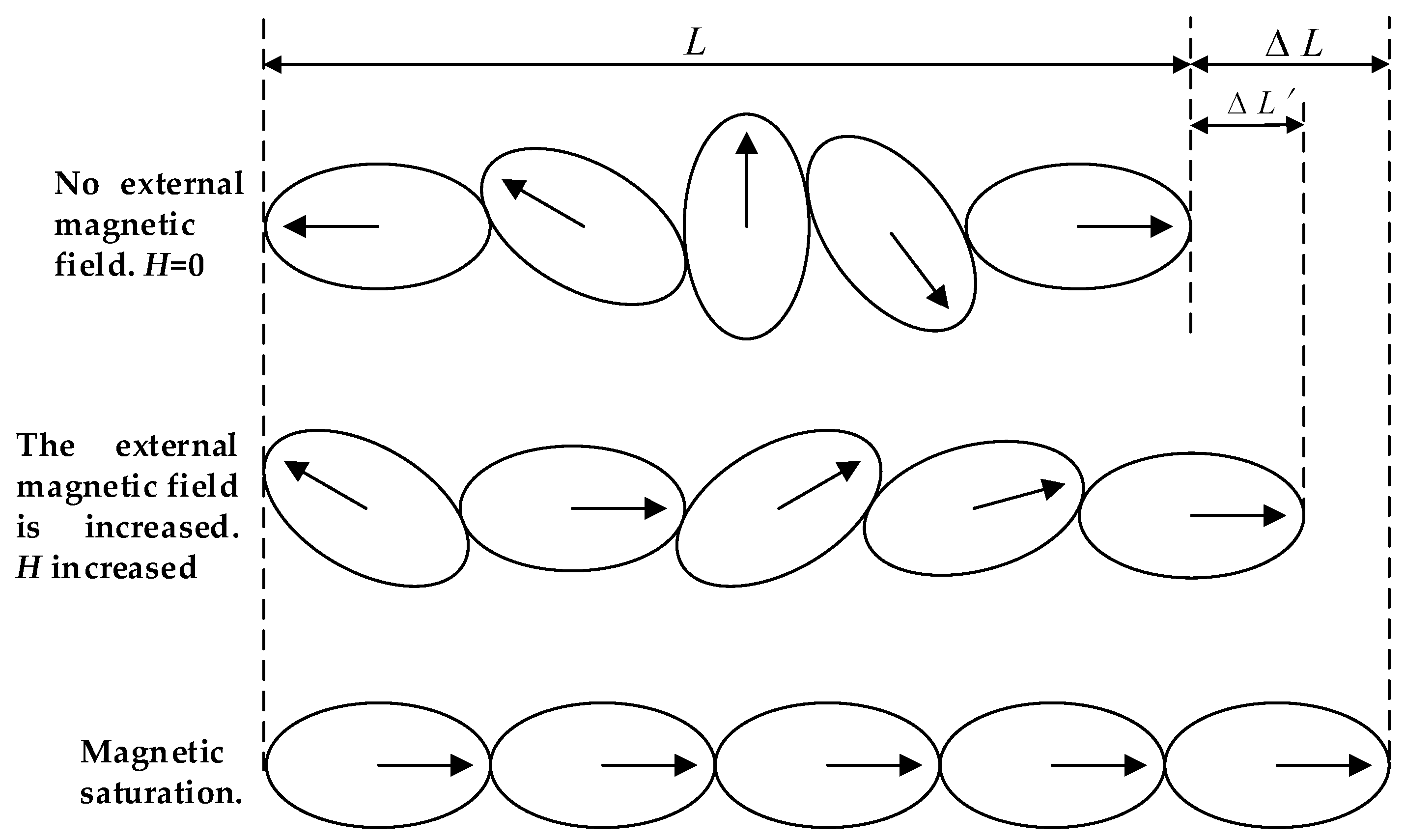





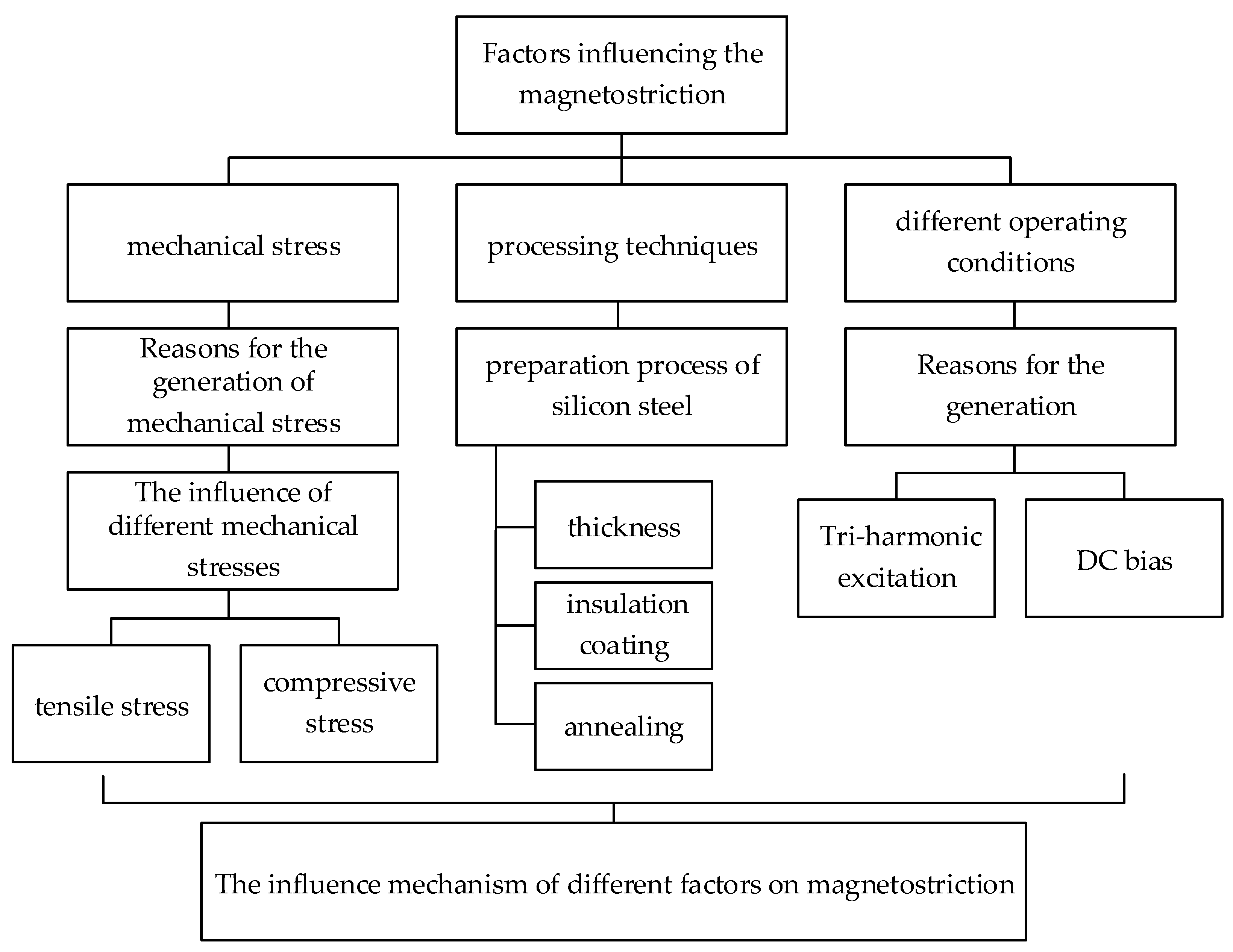
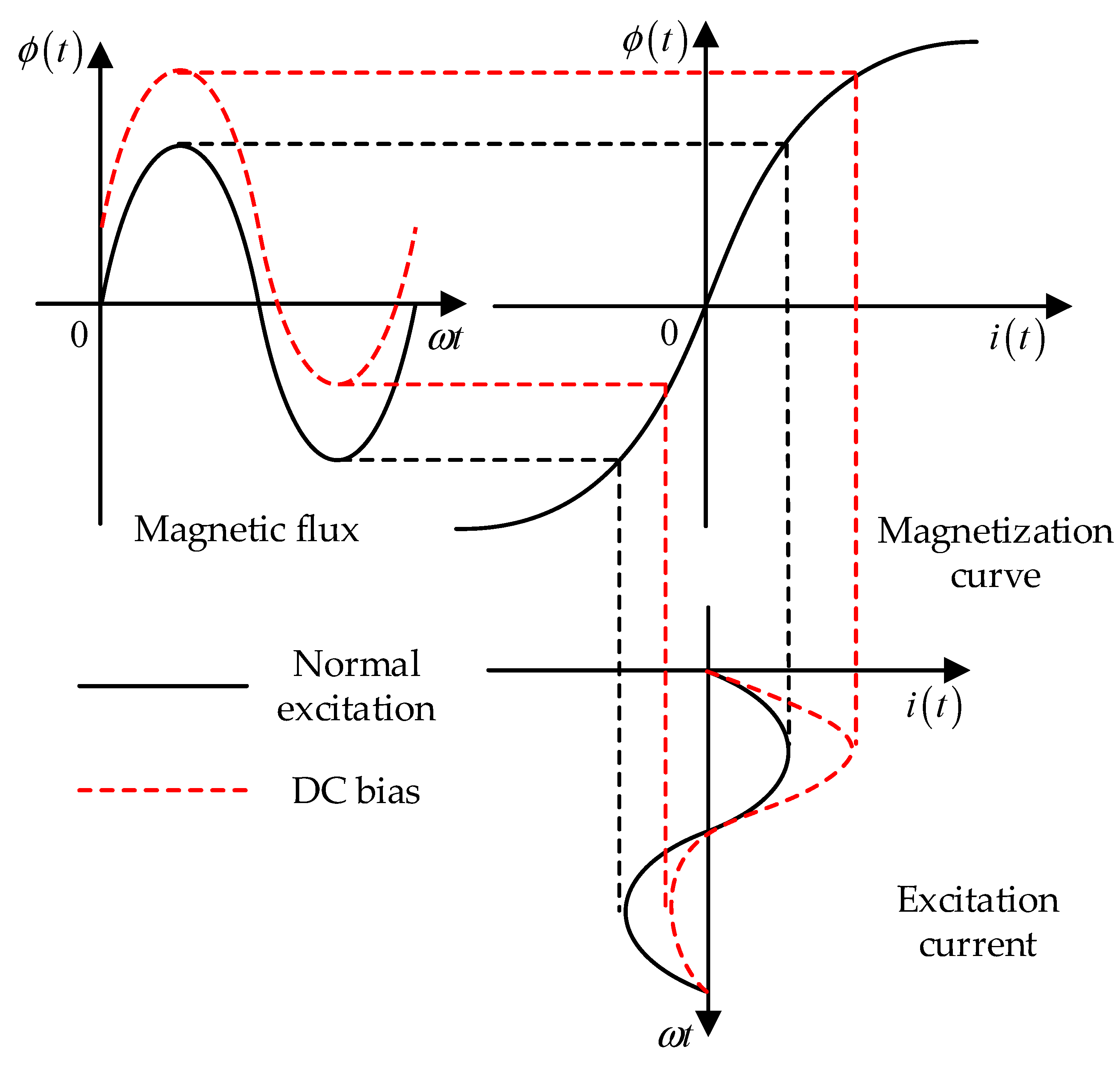
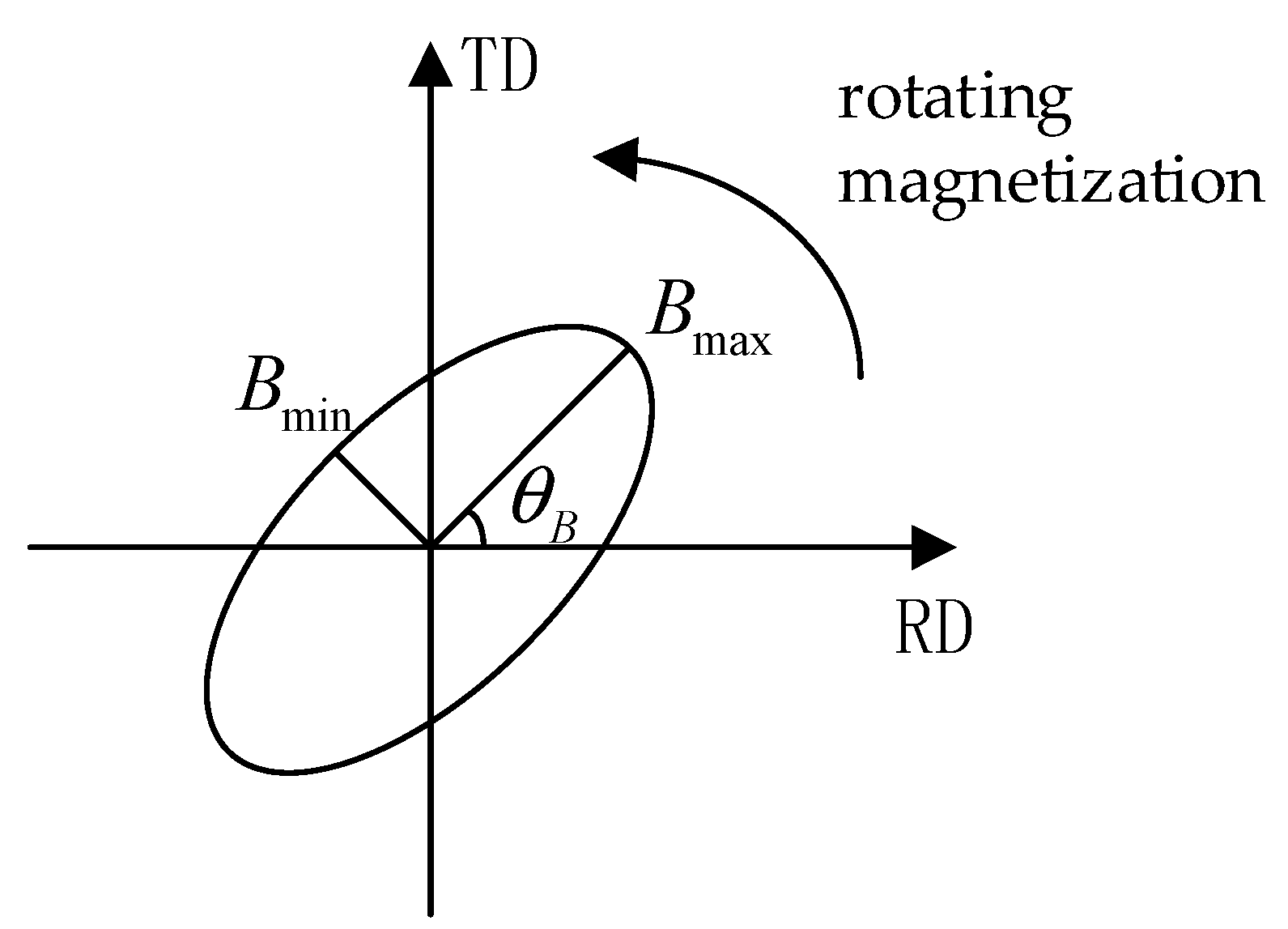
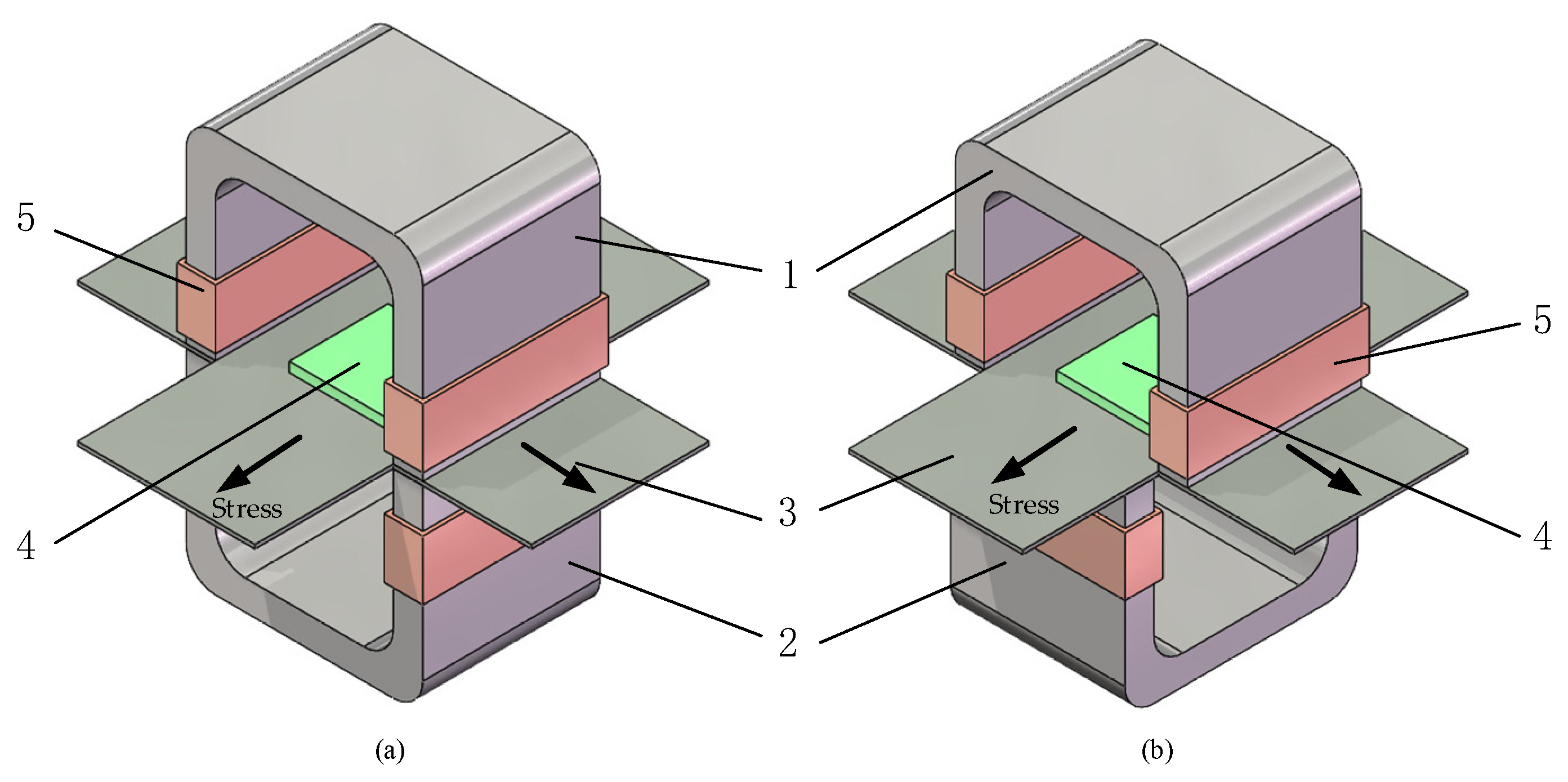
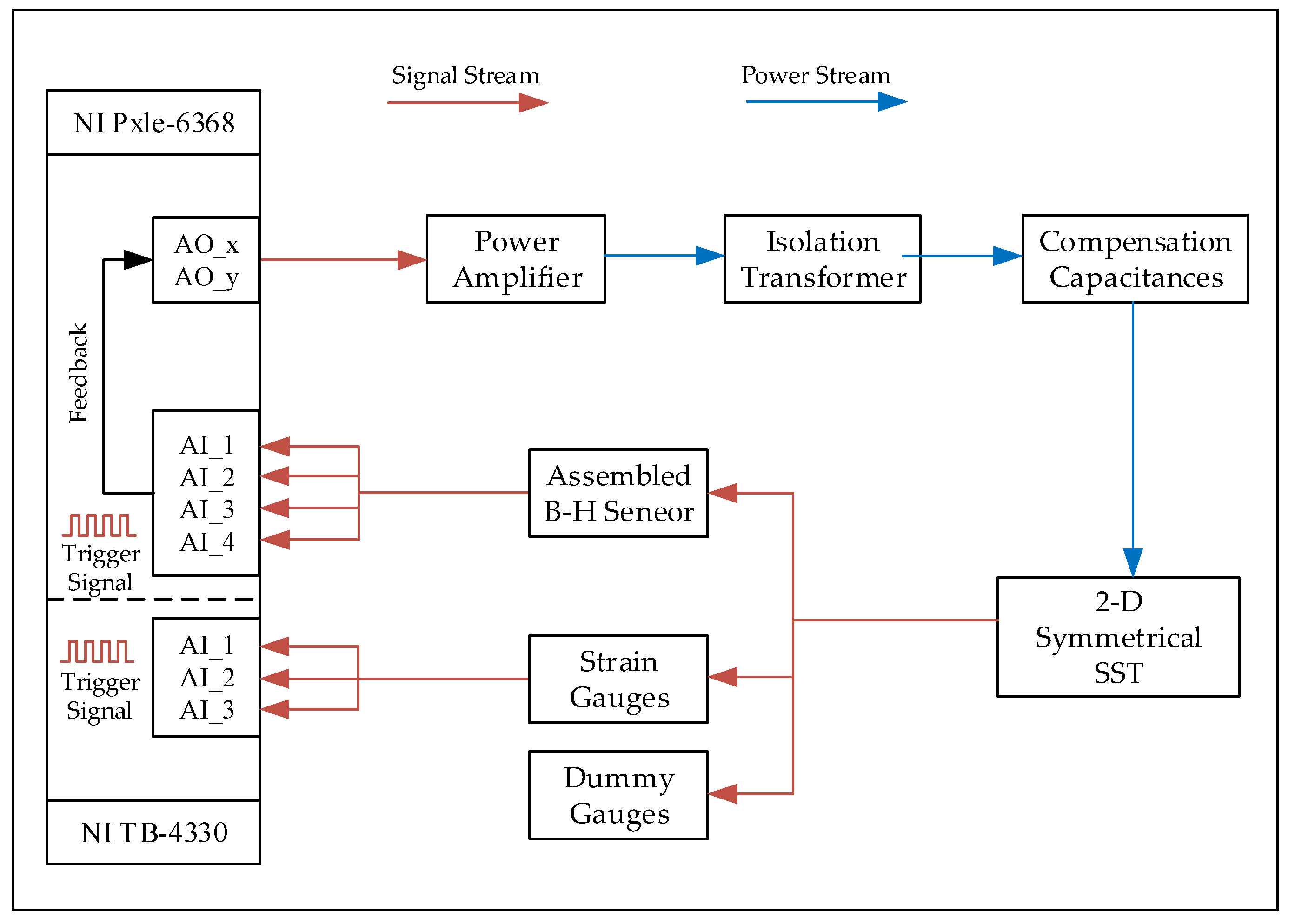

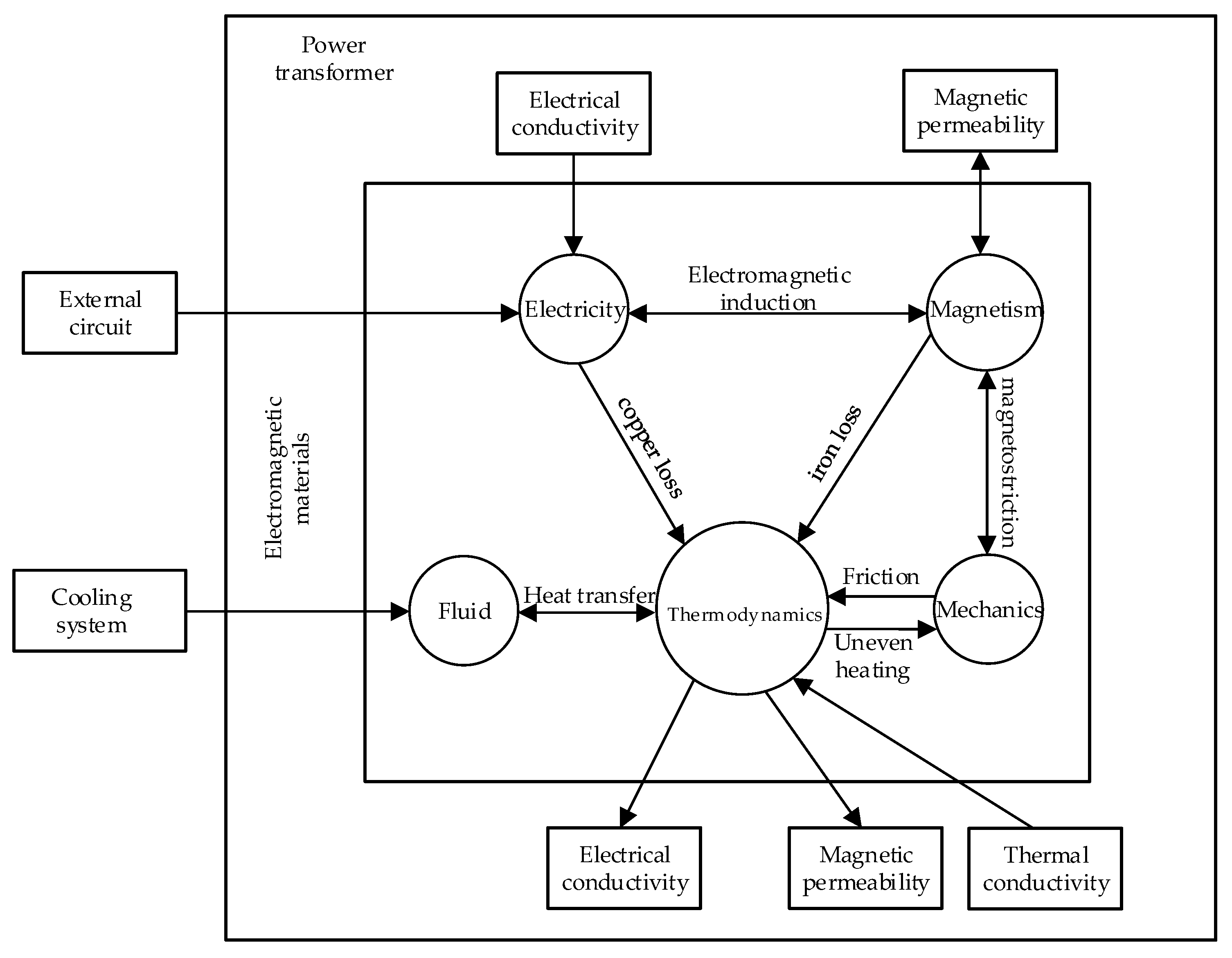
| Characteristics | NO | GO |
|---|---|---|
| Silicon content | Between 0.5% and 3% | 3% or more |
| Saturation magnetic flux density | High | Low |
| Iron loss | High | Low |
| Grain distribution | The grain distribution is uneven and isotropic | Regular arrangement of grains, magnetic anisotropy |
| Scope of application | Electric motor, generator | The choke coil in transformers and electronic instruments |
| Measurement Point | Vibration Peak Frequency (Hz) | The Effective Value of Vibration Acceleration (m/s2) |
|---|---|---|
| 1 | 100 and 200 | 0.072 |
| 2 | 100, 200, 400, and 700 | 0.042 |
| 3 | 100, 400, 450, and 500 | 0.166 |
| 4 | 100, 200, and 650 | 0.041 |
| 5 | 100 | 0.038 |
| Impact Factors | Species | Main Conclusion |
|---|---|---|
| Mechanical stress | Tensile stress | In the RD, the magnetostrictive value decreases, while the magnetostrictive value increases with increasing frequency |
| Compressive stress | In the RD, the magnetostriction value increases, while the magnetostriction value decreases as the frequency increases | |
| Processing techniques | Thickness | The magnetostriction value increases with increasing thickness |
| Insulation coating | Reasonable insulation coating will cause the magnetostrictive value to decrease | |
| Annealing | If the magnetostrictive strain is positive, it will decrease; if it is negative, it will increase | |
| Different operating conditions | Tri-harmonic excitation | Magnetostrictive mainly focuses on 100 Hz and 200 Hz. |
| DC bias | Increase the amplitude of magnetostrictive expansion and change the magnetostrictive strain state |
| Sensor | Strain Gauge | LDV |
|---|---|---|
| Price | Lower price | High price |
| Practicalities | Inconvenience | Easy to deploy |
| Magnetic interference | Measurements affected by magnetic field. Some special gauges can eliminate induction. | Not easily affected by magnetic field |
| Thermal stability | Self-heating; some special gauges can mitigate the thermal dilatation | Good performance |
| Applicability | Good compatibility; easy to apply to existing devices | Worse applicability Need to be considered in design |
| Context of use | Local test; 1D and 2D test | Overall test Mainly 1D test |
| Model | Theoretical Basis | Advantages | Disadvantages |
|---|---|---|---|
| Data testing | Experimental data | For specific excitation modes and material accuracy is better | Large amount of data is required, and high accuracy of data is required |
| Magnetic domain theory | Magnetic domain theory, law of energy conservation | Clear physical basis | Many required parameters, complex calculations |
| Phenomenological theory | Phenomenology theory | Strong mathematical significance | The calculation is inconvenient |
| Thermodynamic relationship | Thermodynamic laws, law of energy conservation | Good universality | Lack of physical foundation |
Disclaimer/Publisher’s Note: The statements, opinions and data contained in all publications are solely those of the individual author(s) and contributor(s) and not of MDPI and/or the editor(s). MDPI and/or the editor(s) disclaim responsibility for any injury to people or property resulting from any ideas, methods, instructions or products referred to in the content. |
© 2024 by the authors. Licensee MDPI, Basel, Switzerland. This article is an open access article distributed under the terms and conditions of the Creative Commons Attribution (CC BY) license (https://creativecommons.org/licenses/by/4.0/).
Share and Cite
Fang, Q.; Ye, Z.; Chen, C. A Review of Power Transformer Vibration and Noise Caused by Silicon Steel Magnetostriction. Electronics 2024, 13, 968. https://doi.org/10.3390/electronics13050968
Fang Q, Ye Z, Chen C. A Review of Power Transformer Vibration and Noise Caused by Silicon Steel Magnetostriction. Electronics. 2024; 13(5):968. https://doi.org/10.3390/electronics13050968
Chicago/Turabian StyleFang, Qikai, Zhihao Ye, and Cheng Chen. 2024. "A Review of Power Transformer Vibration and Noise Caused by Silicon Steel Magnetostriction" Electronics 13, no. 5: 968. https://doi.org/10.3390/electronics13050968
APA StyleFang, Q., Ye, Z., & Chen, C. (2024). A Review of Power Transformer Vibration and Noise Caused by Silicon Steel Magnetostriction. Electronics, 13(5), 968. https://doi.org/10.3390/electronics13050968






